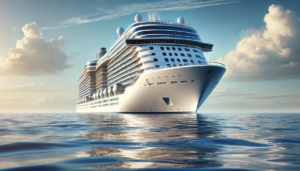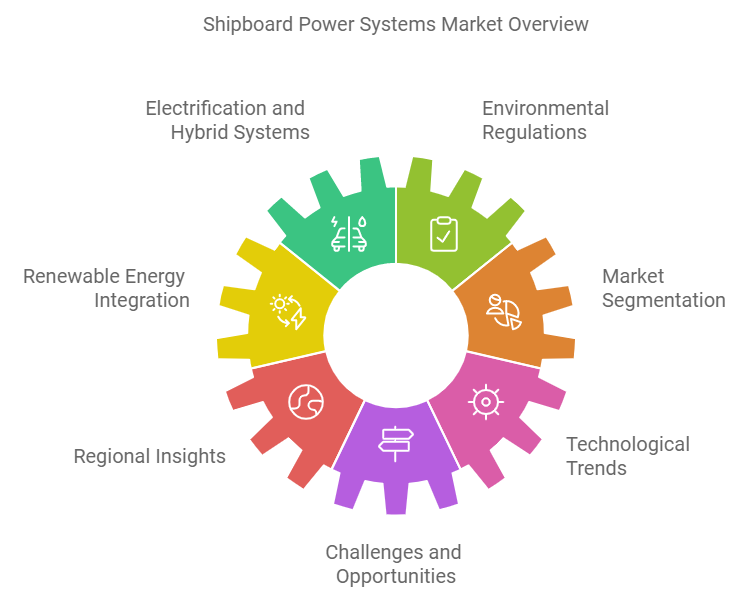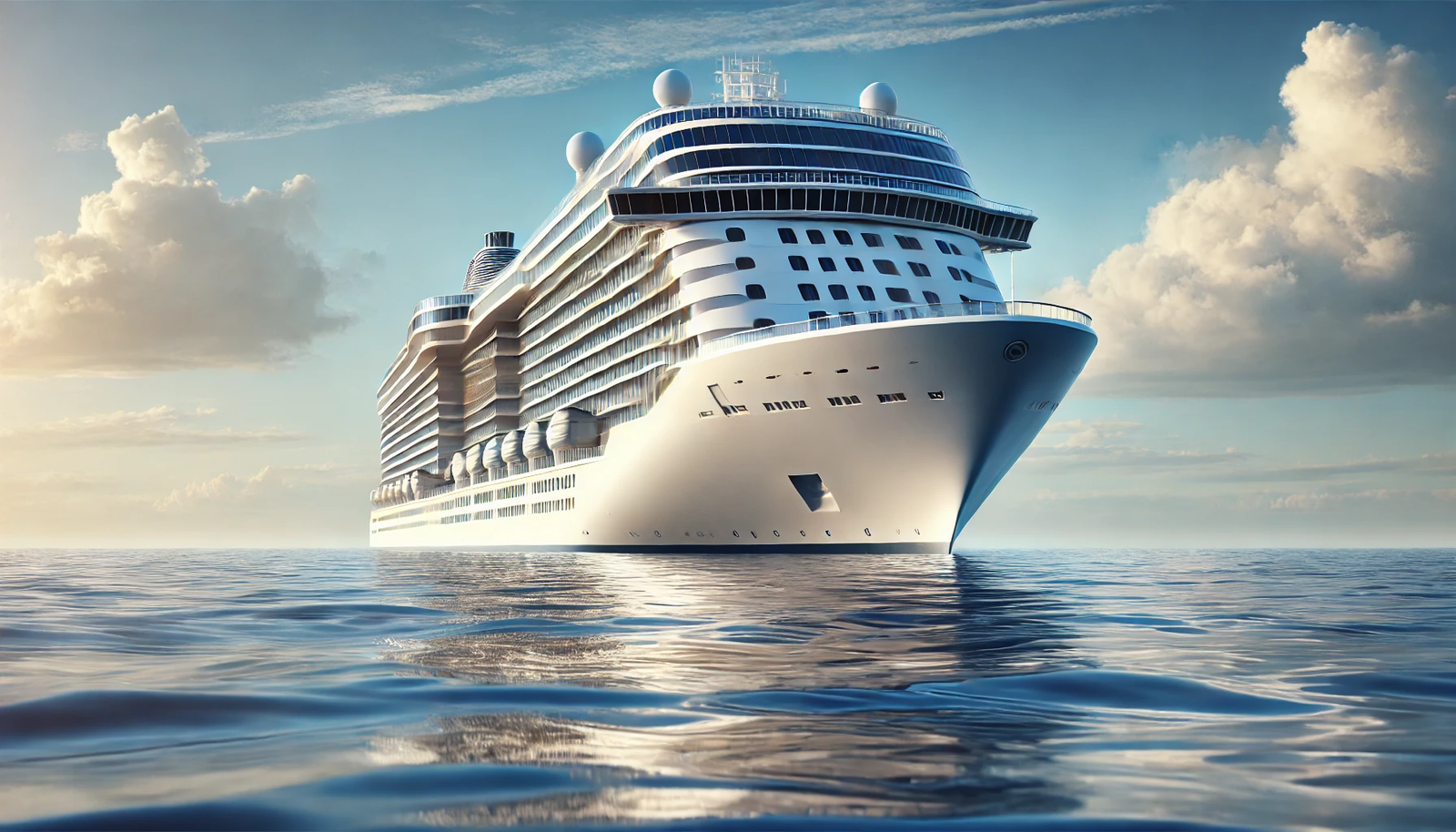The shipboard power systems market is rapidly evolving, with projections indicating significant growth from $1.78 billion in 2024 to $3.61 billion by 2034, reflecting a 7.33% compound annual growth rate (CAGR). Several key factors are driving this growth, including advancements in electric propulsion, increasing environmental regulations, and the integration of renewable energy. This article will delve into the drivers of growth, market segmentation, regional insights, and the technological trends shaping the future of shipboard power systems, providing a comprehensive business-oriented analysis for stakeholders.

1. Introduction to the Shipboard Power Systems Market
The shipboard power systems market is set to undergo substantial growth, reaching a valuation of $3.61 billion by 2034. This growth is driven by the increasing demand for cleaner, more efficient energy solutions in the maritime industry. As global shipping fleets transition to more sustainable operations, the adoption of hybrid and electric power systems is rising, influenced by stricter environmental regulations and economic factors aimed at reducing operational costs.
The importance of shipboard power systems extends beyond propulsion. These systems support various onboard operations, including navigation, communication, and auxiliary services. As such, advancements in power conversion, energy storage, and distribution are integral to meeting the evolving needs of the maritime sector.

2. Key Drivers of Market Growth
2.1 Electrification and Hybrid Systems
The shift towards electrification and hybrid systems is a primary driver of growth in the shipboard power systems market. With an increasing focus on reducing emissions and improving energy efficiency, the adoption of electric and hybrid propulsion is becoming more prevalent. These systems are essential for powering various onboard operations, including lighting, HVAC (Heating, Ventilation, and Air Conditioning), and auxiliary services.
- Electric Propulsion Trends: The maritime industry is increasingly incorporating electric propulsion systems that allow ships to operate with reduced noise and vibration, which is beneficial for passenger comfort and underwater operations. Companies are investing in the development of advanced electric motors and battery technologies to extend the operational range of electric ships.
- Hybrid Propulsion Systems: These systems combine diesel engines with electric motors, allowing vessels to switch between different power sources based on operational needs. For instance, ships can use diesel engines during long voyages and switch to electric power when navigating ports, reducing emissions and fuel consumption.
2.2 Environmental Regulations and Compliance
Stricter environmental regulations are significantly influencing the shipboard power systems market. Regulatory bodies such as the International Maritime Organization (IMO) have set ambitious targets for reducing greenhouse gas emissions by at least 50% by 2050 compared to 2008 levels. This goal is driving the adoption of alternative energy sources and cleaner propulsion technologies.
- Compliance with Emission Standards: Shipowners are investing in energy-efficient technologies and retrofitting existing vessels to comply with new standards. This trend includes the use of scrubbers, LNG (Liquefied Natural Gas) engines, and advanced emission monitoring systems.
- Carbon Neutrality Initiatives: The push towards carbon neutrality in the shipping industry is fostering investment in renewable energy integration and zero-emission ships. Companies are exploring the use of hydrogen fuel cells, ammonia-powered engines, and biofuels as potential solutions to meet future environmental targets.
2.3 Renewable Energy Integration
The integration of renewable energy sources is a growing trend in the shipboard power systems market. This trend helps the maritime industry meet environmental standards while also reducing operational costs over the long term.
- Solar Power Solutions: Solar panels are increasingly being installed on large commercial vessels and leisure yachts to supplement onboard power, particularly for auxiliary services. Solar energy can reduce dependency on traditional fuel sources, contributing to lower operational costs.
- Wind-Assisted Propulsion: Technologies such as rotor sails and rigid wing sails are being used to harness wind power, providing additional propulsion and reducing fuel consumption. This approach is particularly beneficial for cargo ships and tankers, which can achieve significant fuel savings.
3. Market Segmentation Analysis
3.1 Segmentation by Application
The shipboard power systems market can be segmented based on the type of vessels utilizing these systems. Each application has distinct power requirements and growth dynamics.
- Commercial Ships: The largest market segment includes container ships, bulk carriers, and oil tankers. The demand for shipboard power systems in this segment is driven by the need for efficient energy management and compliance with emission regulations.
- Military Vessels: This segment covers naval ships, submarines, and other defense-related vessels. Military applications often require high-performance power systems with enhanced reliability and security features, supporting advanced weaponry, radar systems, and communication equipment.
- Underwater Vehicles and Submarines: These vessels require power systems that can operate efficiently at depths and provide reliable energy for life support, navigation, and scientific equipment. Lithium-ion batteries and fuel cells are commonly used in this segment for their high energy density and long operational life.
- Leisure Ships and Small Recreational Boats: With a growing market for luxury yachts and small boats, the demand for sophisticated power solutions is rising. Electric propulsion and renewable energy integration are popular in this segment for their quiet operation and environmental friendliness.
3.2 Segmentation by Components
The market is also segmented based on the components used in shipboard power systems. Each component plays a crucial role in the system’s efficiency, reliability, and performance.
- Power Conversion Systems: These systems are essential for converting energy from different sources (e.g., from batteries or generators) to usable power for onboard equipment. Inverters, converters, and transformers are commonly used in power conversion.
- Energy Storage Systems: The use of advanced battery technologies such as lithium-ion and solid-state batteries is expanding. Energy storage enables ships to operate on stored power, reducing dependency on traditional generators and lowering emissions.
- Generators: Although traditional diesel generators are still widely used, there is a shift towards gas generators and hybrid solutions that combine generators with battery storage to optimize fuel efficiency.
- Power Distribution Systems: These systems are responsible for the efficient allocation of power throughout the vessel. Modern smart grid solutions allow for real-time monitoring and management of energy consumption, improving overall system efficiency.
4. Regional Market Insights
4.1 Asia Pacific: Leading the Market
The Asia Pacific region is the largest and fastest-growing market for shipboard power systems, driven by significant investments in port infrastructure, economic growth, and a robust shipbuilding industry.
- Key Growth Factors: Countries like China, South Korea, and Japan are leading in shipbuilding, contributing to high demand for shipboard power systems. Additionally, government incentives such as subsidies and tax breaks are stimulating market growth.
- Emerging Technologies: The adoption of smart power management systems, electric propulsion, and renewable energy integration is rising in the region, driven by local policies promoting sustainability and technological innovation.
4.2 Europe: Focus on Sustainability
Europe is a mature market with a strong focus on sustainability and regulatory compliance. The region is home to some of the world’s most stringent environmental standards, pushing shipowners to invest in cleaner power solutions.
- The European Green Deal: The EU’s commitment to achieving net-zero emissions by 2050 is a significant driver of market growth. This has led to increased investments in renewable energy integration and low-emission propulsion systems.
- Innovation Hubs: Norway, Denmark, and Germany are leading in the development of zero-emission ships and advanced energy storage solutions. Companies are actively working on hydrogen-powered ships and all-electric vessels for short-sea shipping routes.
4.3 North America: Defense and Offshore Developments
The North American market is characterized by significant investments in military applications and the offshore oil and gas sector.
- Military Investments: The U.S. Navy and other defense agencies are continuously upgrading their fleets with modern power systems to enhance mission capability and energy efficiency.
- Offshore Oil and Gas Sector: The demand for reliable power solutions in offshore applications is driving investments in hybrid power systems, dynamic positioning, and energy storage technologies.
5. Technological Trends Shaping the Future
5.1 Advanced Energy Storage Solutions
The development of advanced energy storage solutions is transforming the shipboard power systems market. Battery technologies and energy storage solutions are critical for supporting hybrid propulsion systems, enabling ships to operate more sustainably.
- Lithium-Ion and Solid-State Batteries: These batteries offer higher energy densities, longer lifespans, and safer operations compared to traditional batteries, making them suitable for a wide range of maritime applications.
- Fuel Cells: The use of hydrogen fuel cells is gaining traction as a clean alternative for generating onboard power. Fuel cells produce zero emissions and can be used in combination with batteries to form hybrid systems.
5.2 Smart Power Management Systems
Smart power management systems utilize AI and IoT technologies to optimize energy consumption onboard ships. These systems can monitor power usage in real-time, enabling predictive maintenance and reducing the risk of system failures.
- Real-Time Data Monitoring: Sensors and IoT devices can track the performance of shipboard power systems, allowing operators to adjust power distribution as needed to maximize efficiency.
- Digital Twins: The use of digital twin technology in the maritime sector allows for the simulation of shipboard power systems, enabling predictive maintenance and operational optimization.
6. Challenges and Opportunities in the Market
6.1 Challenges
The shipboard power systems market faces several challenges that could hinder its growth.
- High Initial Investment Costs: The adoption of advanced technologies such as hybrid systems and renewable energy solutions involves significant upfront costs, which may be a barrier for some shipowners.
- Technical Complexity: The integration of new energy sources and power systems requires specialized skills and knowledge, which may be challenging for companies lacking expertise in maritime electrification.
6.2 Opportunities
Despite the challenges, the market presents numerous opportunities for growth and innovation.
- Retrofit Market: There is a growing market for retrofitting existing vessels with modern power systems to comply with new environmental standards.
- Autonomous Vessels: The development of autonomous ships is driving the need for reliable power solutions that can support autonomous navigation, communication, and emergency systems.
7. Conclusion
The shipboard power systems market is poised for significant growth, with a 7.33% CAGR projected through 2034. This growth is driven by technological advancements, regulatory trends, and a global push towards sustainable maritime operations. Stakeholders should focus on capitalizing on emerging technologies such as advanced energy storage solutions, smart power management systems, and renewable energy integration to stay competitive in this evolving market.
As the industry continues to shift towards cleaner and more efficient energy solutions, businesses will need to adapt to the changing landscape by investing in innovative technologies and keeping up with regulatory requirements. Those who embrace these trends will be well-positioned to capture new market opportunities and drive the future of shipboard power systems.
Citations:
[3] https://www.giiresearch.com/report/bis1551343-shipboard-power-system-market-global-regional.html
Latest Posts:
- Recycling Water Filtration Market to Hit $3.06 Billion by 2024: Key Drivers Behind the Rapid Growth
- $474 Million in Damages: How Will Hurricanes Impact Future Property Values?
- Tapping into the $6.94 Billion Neuro-Endocrine Tumor Market: Is This the Next Groundbreaking Investment Opportunity?
- Future Market Value: $7.8 Billion by 2030 | Is the Surgical Sutures Market Set for Explosive Growth?
- The Promising Future of the Global Two-Wheeler Catalytic Converter Market: Trends and Projections for 2024-2028

